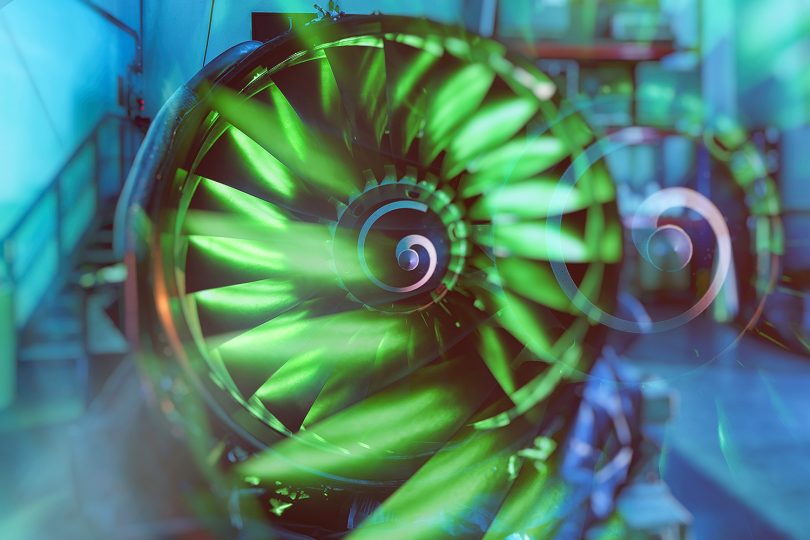Aerospace: Less air friction, less emissions Successful wind tunnel testing of 3D printed extraction panels
Boundary layer flow refers to the properties and behaviour of airflow in the immediate vicinity of a solid surface, such as the wing of an aircraft. This layer, known as the boundary layer, is a thin layer immediately adjacent to the surface in which the flow velocity increases from zero at the surface to the free flow velocity in the surrounding area. Understanding boundary layer behaviour is central to the development of efficient, safe and high performance aircraft. The Cluster of Excellence SE²A for Sustainable and Energy-Efficient Aviation at Technische Universität Braunschweig has succeeded in optimising and testing the boundary layer using adapted suction panels.
One of the goals of the Cluster of Excellence for Sustainable and Energy-Efficient Aviation is to reduce emissions and energy consumption. The flow behaviour of aircraft, especially on the wings, plays a role in this. The researchers are using the Niedergeschwindigkeits-Windkanal Braunschweig (NWB) (Braunschweig Low-Speed Wind Tunnel) of the German-Dutch Wind Tunnel Foundation (DNW) for their experiments. The wind tunnel produces a very low level of turbulence, so that the boundary layer behaviour of the flow can be simulated similarly to free-flight experiments. It was also essential to use a highly modular laminar model to demonstrate the efficiency of different suction surfaces, with the help of the German Aerospace Centre (DLR), which allowed the direct installation of 3D-printed panels.
In an experiment, TU Braunschweig, in close cooperation with DLR, demonstrated that it is possible to achieve a so-called laminarisation of the boundary layer using micro-perforated – i.e. with tiny holes – suction plates from the 3D printer. A small part of the boundary layer is sucked through the microperforated surface, stabilising it.
With the new suction panels, the boundary layer of aerodynamic bodies can be modified in such a way that the laminar-turbulent transition is shifted further downstream and the proportion of the laminar boundary layer is significantly increased. The advantage of this is that the laminar boundary layer causes up to 90 per cent less air friction than the turbulent boundary layer. Air friction accounts for about half of the total drag in modern commercial aircraft. “Laminar flow control is therefore a way of significantly reducing the fuel consumption and therefore the emissions of commercial aircraft,” says Hendrik Traub from TU Braunschweig, who is responsible for the production of the 3D-printed surfaces.
Of interest to science and the design of gliders, light aircraft and commercial aircraft
Producing the particularly fine microperforations with a diameter of less than 250 microns was a challenge for the printers. Hendrik Traub: “Finding a suitable perforation geometry was therefore an important part of our research work. The ability to print such surfaces now makes it possible to produce three-dimensional curved suction surfaces quickly and cost-effectively. This is interesting for science as well as for gliders, light aircraft and commercial aircraft.”
Why 3D printing?
Until now, suction panels for scientific applications have been made from stainless steel or titanium sheets micro-perforated either by etching or laser drilling. Both processes produce industrial-grade suction surfaces that have been successfully tested in flight. For example, to produce curved suction panels that follow a wing contour, the sheets are bent after perforation and glued or welded to a supporting structure. However, sheet bending is limited to 2D curvatures and the subsequent joining of substructures partially closes the perforations, although this has been shown to have only a minor impact on efficiency. 3D printing eliminates all of these steps. The process allows different geometries, perforation arrangements and substructures to be combined and produced, although the surface roughness is currently still slightly higher.
It took four years of preparation to test the suction panels. “First, we analysed various 3D printing processes for their suitability for manufacturing suction panels. We then analysed printable perforation geometries and substructures. The perforation geometries had to allow the printing of very small holes, and the substructures had to provide a dense but permeable support for the microperforated skin without blocking the holes again.”
Once the researchers had found the optimum combination, they scaled up the smaller prototypes to complete suction panels for the wind tunnel. The geometrically complex but very printable minimal surface substructure pushed the performance limits of the CAD and printer software, so they had to switch to a new software architecture with specially programmed libraries. “The challenge lies in the extreme contrast between very precise geometric details, which have to be resolved to within a few micrometres, and the relatively large dimensions of the suction panels themselves.”
Full laminar wing production planned for 2025
The next major step is to develop and manufacture a second version of the suction plate with a further improved surface for off-design cases without suction. By improving the surface quality, the efficiency can be increased and a laminar run length similar to that over a smooth, non-perforated surface can be achieved even without suction. This is important during flight phases when the suction system is switched off or has failed. These tests will again take place in the Niedergeschwindigkeits-Windkanal Braunschweig. Based on these models, the first three-dimensionally curved suction panels for a fully laminar wing model developed by the Institute of Fluid Mechanics will be produced in 2025.
About the project
While the concept and production were developed at the Institute of Mechanics and Adaptronics (TU Braunschweig), the ongoing aerodynamic pre-tests were carried out in cooperation with the Institute of Fluid Mechanics (Konstantin Thamm, Lajos Fohlmeister, TU Braunschweig). The final wind tunnel test and the model provided were carried out together with the instrumentation by the DLR (Richard von Soldenhoff, Heinrich Lüdeke, Institute of Aerodynamics and Flow Technology).

